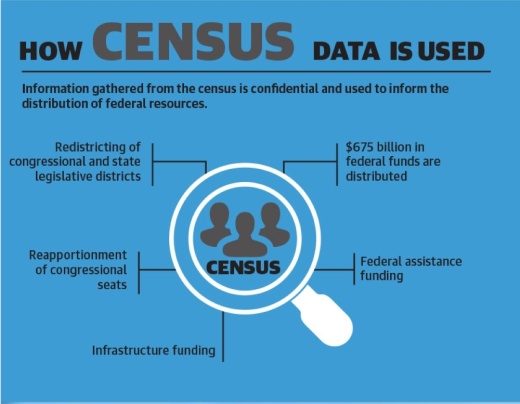Michael Meek, New Braunfels Chamber of Commerce president, is chair of the Complete Count Committee, a group raising awareness of the census and encouraging participation, according to the chamber’s website.
The census occurs every 10 years, as mandated by the Constitution, and is used to determine how federal funding is distributed to communities for the next decade.
“We’re all paying taxes, and they all get sent up to the federal government,” Meek said. “They get reapportioned back but not equally. It’s reapportioned back based on the census to a large degree.”
Census questions include the number of people living in a home and whether the home is owned or rented. The following information will be asked for each household member: name; phone number; gender; age; race; and whether they are of Hispanic, Latino or Spanish origin.
Meek was quick to point out that this information is not shared with any organization other than the Census Bureau and cannot be used against respondents by any government agency or court, and doing so carries stiff penalties.
Title 13 of the United States Code states that census officials are sworn to protect confidentiality for the duration of their life, and violations can result in a fine of up to $250,000 and/or up to five years in federal prison.
The census or its representatives will never ask for Social Security numbers, donations, political affiliations or financial information, according to the Census Bureau’s website.
Census results also determine the distribution of congressional seats within the U.S. House of Representatives for the next decade.
Data from the headcount is also the basis for funding of federal programs such as SNAP, Section 8 housing, school lunches, Head Start programs and more.
The official 2020 census website states that data will “inform decisions about allocating hundreds of billions of dollars in federal funding to communities across the country—for hospitals, fire departments, school lunch programs, and other critical programs and services.”
Funding for Medicare, substance abuse programs, Pell Grants and federal infrastructure are also reliant on census information.
Participation is essential to rapidly growing cities like New Braunfels. In 2010, New Braunfels’ population was under 60,000. In 2018, it was estimated to be 84,612, according to the Census Bureau’s website.
Undercounting can widen the margin between what is needed and provided as the decade continues and demand for resources will be difficult or impossible to meet at the state and local levels.
“For every person that doesn’t fill it out or get counted, it costs [New Braunfels] $1,100 per person per year for 10 years,” Meek said. “When you’re America’s second fastest-growing city, you need every dollar coming back that you can get, and then some.”
The census is also used by businesses to determine where they’ll do business. According to the census website, “the results provide a rich set of data on the communities they serve, including population trends and growth projections.”
The 2020 census will be the first to go digital, and participants can respond online, by phone or by mail.
In April, census takers will begin the process of visiting students living on-campus and residents of senior centers, according to the census website. Starting in May and through July, census takers will begin knocking on doors of homes that have not responded.
Meek said the census may be completed online in 13 languages, and phone operators are available in more than 60 languages.
“We have a lot riding on this deal,” Meek said.






